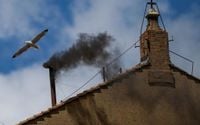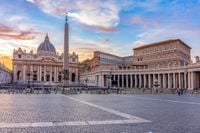As the world holds its breath, the conclave at the Vatican continues into its second day without a new pope. On May 8, 2025, black smoke billowed from the chimney atop the Sistine Chapel, signaling that the cardinals had not reached a decision during their morning voting session. This marked the second consecutive day of voting without a definitive outcome, as the cardinals grapple with the monumental task of selecting the successor to Pope Francis, who passed away on April 21, 2025.
The conclave commenced on May 7, 2025, at 4:30 PM, with 133 cardinal-electors gathered in the Sistine Chapel. Following a solemn oath to maintain secrecy, the cardinals began their deliberations. The first round of voting took place that evening, but as the clock struck 9:00 PM, black smoke emerged, indicating that no candidate had garnered the necessary two-thirds majority—89 votes required to elect a new pope.
With anticipation building, thousands of faithful congregated in St. Peter's Square, hoping for a sign of the church's new leader. By mid-morning on May 8, another round of voting was underway, following a mass and morning prayers held in the Pauline Chapel. The cardinals returned to the Sistine Chapel around 9:15 AM to engage in prayer and voting once again. If a pope were to be elected during this session, the world could expect to see white smoke around 10:30 AM or 12:00 PM. However, as the clock approached noon, black smoke once again signaled the continuation of the conclave.
The process of electing a new pope is steeped in tradition and ritual. When a new pope is chosen, the smoke released from the chimney turns white, and the announcement is made with the famous words "Habemus Papam" from the balcony of St. Peter's Basilica. If no decision is reached during the morning sessions, the cardinals will break for lunch before resuming their voting in the afternoon, with potential results expected by 5:30 PM or 7:00 PM.
The stakes are high for the cardinals as they navigate this complex and critical decision. The new pope will not only serve as a spiritual leader to nearly 1.5 billion Catholics worldwide but will also be tasked with addressing the Vatican's intricate financial affairs—an ongoing challenge that Pope Francis began to tackle during his papacy.
Historically, the conclave can last anywhere from a few hours to several days. In recent decades, popes have typically been elected by the second or third day of the conclave. For instance, Karol Wojtyła became Pope John Paul II on the third day of voting in 1978, while both Benedict XVI and Pope Francis were elected on the second day of their respective conclaves.
As the cardinals deliberate, the eyes of the world are firmly fixed on the chimney of the Sistine Chapel. The black smoke serves as a reminder of the challenges ahead, and the faithful await the moment when white smoke will finally signal the election of the 267th pope. With the unprecedented number of cardinal-electors appointed by Pope Francis himself, many speculate that the next pope may continue his legacy of reform and openness within the church.
Among the cardinal-electors are four from Poland: Stanisław Ryłko, Kazimierz Nycz, Konrad Krajewski, and Grzegorz Ryś. All are eligible to vote as they have not surpassed the age limit of 80 years. Their presence in the conclave adds another layer of intrigue to the proceedings, as the influence of Polish cardinals has historically been significant within the Catholic Church.
The conclave's outcome will not only shape the future of the Roman Catholic Church but also impact international politics and social issues such as climate change, migration, and global conflicts. As discussions continue behind closed doors, the world waits with bated breath for the announcement of the new papal leader.
With the next round of voting scheduled for the afternoon, the hope remains that the cardinals will find common ground and select a new pope who can unite and guide the church through the complexities of modern times. Until then, the black smoke serves as a poignant reminder of the weighty responsibility resting on the shoulders of the cardinal-electors.


![Drugi dzień konklawe. Czarny dym nad Kaplicą Sykstyńską [AKTUALIZACJA]](https://thumbor.evrimagaci.org/kOCYrEycdhSG1AywKWVg0WFhf-A=/200x0/tpg%2Fsources%2Fbe047bac-a10b-4f59-a66d-23fd6e3efaea.jpeg)
